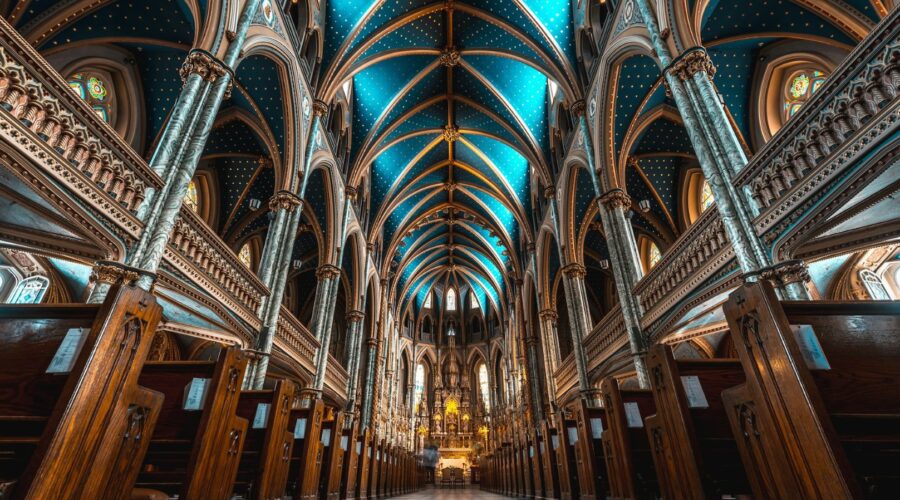Your cart is currently empty!
Discover the Splendors of the Sacred Heart Church: A Comprehensive Guide

A Beacon of Faith and Architectural Marvel
Nestled amidst the vibrant tapestry of Barcelona, Spain, the Sacred Heart Church stands as a testament to the grandeur of Gothic Revival architecture. Conceived by the renowned architect Antoni Gaudí, this awe-inspiring basilica is a culmination of his visionary artistry and a profound symbol of faith.
Historical Context
The inception of the Sacred Heart Church can be traced back to 1874, when the Josep Maria Bocabella, a fervent Catholic, purchased a plot of land on the outskirts of Barcelona with the intention of erecting a temple dedicated to the Sacred Heart of Jesus. Gaudí was entrusted with the architectural design in 1883, embarking on a project that would span four decades and become one of his most enduring masterpieces.
Architectural Prowess
The Sacred Heart Church is a symphony of architectural brilliance, showcasing Gaudí’s signature style that seamlessly blends Gothic, Art Nouveau, and Modernista elements. The majestic façade is adorned with intricate carvings, vibrant mosaics, and soaring spires, creating an ethereal presence that captivates all who behold it.
Façade
The façade of the Sacred Heart Church is divided into three distinct sections, each representing a stage in the life of Christ. The lower section, known as the Nativity Façade, depicts the birth and early life of Jesus. The central section, the Passion Façade, portrays scenes from his crucifixion, death, and resurrection. The upper section, the Glory Façade, celebrates the ascension of Christ and the triumph of the Catholic Church.
Towers and Spires
The Sacred Heart Church boasts a total of eighteen towers and spires, each meticulously designed to convey a specific religious symbolism. The central tower, known as the Tower of Jesus Christ, reaches a height of 170 meters and is adorned with a gilded statue of Christ holding a cross. The twelve apostles are represented by the remaining towers, while the four evangelists are symbolized by the pinnacles on each corner of the church.
Interior
The interior of the Sacred Heart Church is a testament to Gaudí’s genius for creating spaces that inspire both awe and introspection. The nave is a vast and soaring space, supported by slender columns that resemble trees, creating a serene and otherworldly atmosphere. The stained-glass windows, designed by Joan Vila-Grau and crafted by Josep Maria Jujol, bathe the interior in a kaleidoscope of colors.
Crypt
Beneath the main altar of the Sacred Heart Church lies the crypt, where the remains of Antoni Gaudí rest. The crypt is a somber and reflective space, adorned with sculptures and mosaics that pay homage to the architect’s life and work.
Symbolism and Inspiration
The Sacred Heart Church is a profound manifestation of Gaudí’s faith and his unwavering belief in the power of architecture to uplift and inspire. The basilica is replete with religious symbolism, from the intricate carvings depicting biblical scenes to the ingenious use of light and color.
The Sacred Heart of Jesus
The central theme of the Sacred Heart Church is the devotion to the Sacred Heart of Jesus, a symbol of divine love and compassion. The basilica is dedicated to the worship and veneration of this sacred symbol, and many of its architectural elements are designed to evoke the heart of Christ.
Light and Color
Gaudí masterfully employed light and color to create an immersive and awe-inspiring experience within the Sacred Heart Church. The stained-glass windows, mosaics, and painted ceilings emit a symphony of colors that shift and dance with the changing light throughout the day. This play of light and color is intended to symbolize the divine presence and the transformative power of faith.
Nature and Symbolism
Gaudí’s profound love for nature is evident throughout the Sacred Heart Church. The columns resemble trees, the stained-glass windows evoke the colors of flowers, and the mosaics depict scenes from the natural world. This integration of nature into the church’s design serves as a reminder of the interconnectedness of all living things and the sacredness of creation.
Visiting the Sacred Heart Church
The Sacred Heart Church is a must-see destination for visitors to Barcelona. Here are some tips for planning your visit:
* Book Tickets in Advance: Due to its immense popularity, it is highly recommended to book tickets online in advance to secure your preferred visiting time.
* Guided Tours: Guided tours are available in multiple languages and provide an in-depth exploration of the church’s history, architecture, and symbolism.
* Appropriate Attire: As a place of worship, it is customary to dress respectfully when visiting the Sacred Heart Church. Revealing or casual clothing is discouraged.
* Photography: Photography is generally permitted within the church, but it is important to be mindful of other visitors and to avoid using flash.
* Accessibility: The Sacred Heart Church is accessible to visitors with disabilities. Wheelchair ramps and elevators are available throughout the building.
Conclusion
The Sacred Heart Church is a masterpiece of modern architecture, a symbol of faith, and a testament to the boundless creativity of Antoni Gaudí. Its grandeur, symbolism, and spiritual significance continue to captivate and inspire visitors from around the globe. Whether you are a devout Catholic, an architecture enthusiast, or simply a traveler seeking a truly awe-inspiring experience, the Sacred Heart Church is an unforgettable destination that will leave an enduring impression on your heart and soul.